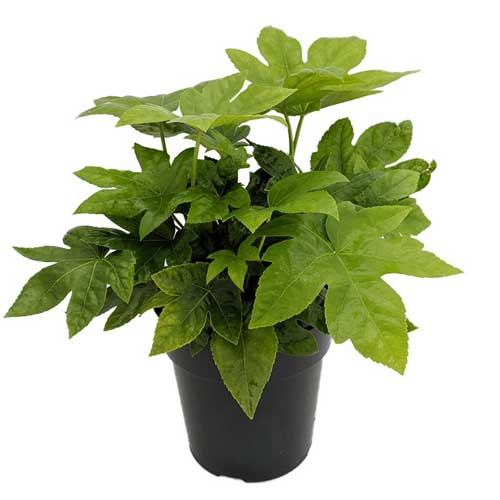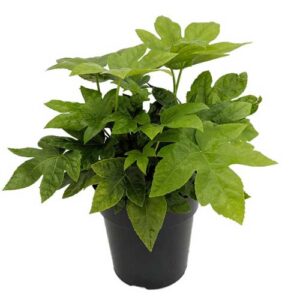About Japanese Aralia

Japanese Aralia Introduction
The Japanese Aralia (Fatsia japonica) is a striking evergreen shrub native to the coastal areas of Japan, South Korea, and Taiwan. This architectural plant is characterized by its large, glossy, palm-like leaves that can grow up to 16 inches (40 cm) wide, creating a bold tropical appearance in any setting.
The plant typically grows in a naturally rounded form, reaching heights of 6-10 feet (1.8-3 meters) with a similar spread in optimal conditions. Its leaves are deeply lobed with 7-9 segments, creating a dramatic silhouette that adds instant exotic appeal to both indoor and outdoor spaces.
In late autumn to early winter, Japanese Aralia produces clusters of small, creamy-white flowers held in conspicuous spherical umbels, followed by small black berries. These flowers, while not particularly showy, attract pollinators and add seasonal interest to the plant. The plant’s versatility allows it to thrive both as an indoor specimen and an outdoor landscape element in suitable climates.
Japanese Aralia Care & Growing Guide
Caring for Japanese Aralia requires attention to its tropical origins while being forgiving enough for beginners. The plant thrives in environments that mimic its natural habitat, preferring partial shade and consistent moisture without waterlogging.
When grown indoors, Japanese Aralia appreciates regular misting to maintain humidity and requires well-draining soil to prevent root rot. The plant benefits from regular feeding during the growing season and appreciates occasional pruning to maintain its shape and remove any yellowing or damaged leaves.
One of the most crucial aspects of Japanese Aralia care is protecting it from extreme temperatures and harsh direct sunlight. While adaptable, it performs best when given consistent care and protection from cold drafts and intense afternoon sun. Regular monitoring for pests and maintaining proper air circulation will help ensure the plant remains healthy and vibrant.
 Soil
Soil
Japanese Aralia thrives in rich, well-draining soil with a pH range of 6.0-7.5. The ideal soil composition includes a mixture of regular potting soil, peat moss, and perlite to ensure proper drainage while retaining adequate moisture. Add organic matter to improve soil structure and nutrient content.
Soil problems to watch for:
– Poor drainage: Can lead to root rot and fungal diseases
– Compaction: Restricts root growth and water penetration
– Inappropriate pH: Affects nutrient availability
– Salt build-up: Can occur from hard water or over-fertilization
– Nutrient deficiencies: May show as yellowing leaves or stunted growth
– Root boundness: Can occur in containers, requiring repotting
 Fertilizer
Fertilizer
Feed monthly during growing season with balanced, water-soluble fertilizer (10-10-10). Reduce fertilization in winter. Signs of over-fertilization include leaf burn and salt buildup. Organic alternatives include compost tea or fish emulsion.
 Watering
Watering
Water requirements vary seasonally, with more frequent watering needed during active growth periods and reduced watering during winter. The plant prefers consistently moist but not waterlogged soil.
Signs of overwatering:
– Yellowing leaves
– Soft, mushy stems
– Root rot
Signs of underwatering:
– Drooping leaves
– Crispy leaf edges
– Slow growth
 Lighting
Lighting
Japanese Aralia performs best in bright, indirect light or partial shade. Direct sunlight can scorch the leaves, while insufficient light leads to leggy growth and reduced leaf size. Symptoms of poor lighting include:
Too much light:
– Yellowing or bleached leaves
– Crispy brown edges
– Wilting
Too little light:
– Elongated stems
– Smaller leaves
– Reduced growth
– Pale foliage
 Temperature
Temperature
Ideal temperature range is 60-75°F (15-24°C). Protect from:
– Cold drafts
– Heating vents
– Temperatures below 50°F (10°C)
– Sudden temperature changes
 Humidity
Humidity
Japanese Aralia prefers humidity levels between 40-60%. Increase humidity through:
– Regular misting
– Pebble trays with water
– Humidifiers
– Grouping with other plants
Low humidity symptoms:
– Crispy leaf edges
– Brown leaf tips
– Leaf drop
 Propagation
Propagation
1. Stem cuttings:
– Take 6-inch cuttings in spring
– Remove lower leaves
– Dip in rooting hormone
– Plant in moist potting mix
– Maintain warm temperatures
– Roots develop in 4-6 weeks
2. Division:
– Separate offshoots in spring
– Ensure each division has roots
– Replant immediately
– Keep soil moist until established
 Potting
Potting
Repot every 2-3 years or when roots become crowded. Use containers with drainage holes and well-draining potting mix. Signs for repotting include:
– Roots growing through drainage holes
– Slowed growth
– Plant becoming top-heavy
– Water running straight through pot
 Pruning
Pruning
Pruning Guide for Japanese Aralia
Timing
– Best done in early spring
– Remove dead or yellowing leaves year-round
Steps
1. Sterilize pruning tools
2. Remove dead or damaged leaves at the base
3. Cut back overgrown stems to maintain shape
4. Trim flowering stalks after blooming
5. Clean up debris
Aftercare
– Reduce watering slightly
– Monitor for new growth
– Apply balanced fertilizer after 2 weeks
 Blooming
Blooming
 Pests and Diseases
Pests and Diseases
pests
common_issues
Spider mites
Scale insects
Mealybugs
symptoms: Yellowing leaves, webbing, sticky residue, visible insects
treatment: Insecticidal soap, neem oil, regular inspection and cleaning
diseases
common_issues
Root rot
Leaf spot
Powdery mildew
symptoms: Wilting, brown spots, white powder on leaves
treatment: Improve air circulation, adjust watering, fungicides if necessary
 Special Features
Special Features
Japanese Aralia is prized for its architectural value and tropical appearance. The large, glossy leaves create dramatic shadows and add instant exotic appeal to any space. The plant’s winter blooms provide additional interest, while its air-purifying qualities make it a beneficial addition to indoor environments.
 Plant Benefits
Plant Benefits
While not commonly used medicinally, Japanese Aralia contains compounds with potential anti-inflammatory properties. Traditional Asian medicine has used parts of the plant to treat various ailments, though scientific research is limited.
 Additional Information
Additional Information
Japanese Aralia is often used in traditional Japanese gardens and has cultural significance in its native regions. The plant has received the Royal Horticultural Society’s Award of Garden Merit.
 Life Cycle
Life Cycle
Evergreen perennial that maintains foliage year-round. Growth is most active in spring and summer, with flowering occurring in late autumn to winter. Plants can live many years with proper care.
 Are Japanese Aralia Poisonous, Toxic
Are Japanese Aralia Poisonous, Toxic
Japanese Aralia is toxic to cats and dogs if ingested. All parts contain saponins that can cause:
– Gastrointestinal upset
– Vomiting
– Diarrhea
– Oral irritation
First aid:
1. Remove plant material from mouth
2. Contact veterinarian
3. Monitor for symptoms
Preventive measures:
– Keep plant out of reach
– Use deterrent sprays
– Consider alternative pet-safe plants
 Frequently Asked Questions
Frequently Asked Questions
Is Japanese Aralia toxic to pets?
Yes, Japanese Aralia is toxic to cats and dogs if ingested, causing gastrointestinal upset and oral irritation.
How often should I water Japanese Aralia?
Water when the top inch of soil feels dry, typically every 5-7 days, adjusting frequency based on season and environment.
How big does Japanese Aralia grow?
Japanese Aralia can grow 6-10 feet tall and wide in optimal conditions.
Can Japanese Aralia grow indoors?
Yes, Japanese Aralia can thrive indoors with proper light, humidity, and care.
What type of light does Japanese Aralia need?
Japanese Aralia prefers bright, indirect light or partial shade.
How do you propagate Japanese Aralia?
Japanese Aralia can be propagated through stem cuttings or division in spring.
Does Japanese Aralia flower?
Yes, Japanese Aralia produces small white flowers in late autumn to early winter.
What temperature does Japanese Aralia prefer?
Japanese Aralia thrives in temperatures between 60-75°F (15-24°C).
How often should I fertilize Japanese Aralia?
Fertilize monthly during the growing season with a balanced fertilizer, reducing in winter.
What are common problems with Japanese Aralia?
Common problems include spider mites, scale insects, root rot, and leaf spot diseases.
 Can I grow Japanese Aralia in my indoor space
Can I grow Japanese Aralia in my indoor space
Difficulty
Size
Light
Water
Flowering
Pet Safe
Air Purifier
 Fatsia japonica botanical details
Fatsia japonica botanical details
Common Name
Other Common Names
Botanical Name
Native Area
Family Name
Plant Type
Genus
Kingdom
 Photo Gallery
Photo Gallery
- Perky Plant fertilizer: https://amzn.to/3RdLA00
- Seaweed extract: https://amzn.to/3z2CsFh
- Rooting hormone: https://amzn.to/3bIXi0t
- Espoma fertilizer: https://amzn.to/3vPa9bs
- Worm compost: https://amzn.to/3HVL01u
- Full-spectrum Light Bulb-Large: https://amzn.to/3yR6VBu
- Full-spectrum Lighting: https://amzn.to/3qhhaiv
- Light meter: https://amzn.to/4dpmp3s
- Moisture meter: https://amzn.to/3TEUu5N
- Hygrometer: https://amzn.to/3Cf6h2F
- Pruning shears: https://amzn.to/3X6oOcg
- ProMix Potting Soil: https://amzn.to/3iVIrjE
- My Organic Green Gourmet Houseplant Fertilizer: healthyhouseplants.storenvy.com
- My Perfect Pumice: Healthy Houseplants Store
- My Organic Green Gourmet Houseplant Fertilizer: Healthy Houseplants Store
As an Amazon Associate, I earn commission from qualifying purchases.
 Plant Puns and Jokes
Plant Puns and Jokes
Why don’t Japanese Aralias like parties? Because they can’t leaf the house!




 My Japanese Aralia Plant Care Recommendations
My Japanese Aralia Plant Care Recommendations Buy Japanese Aralia Online
Buy Japanese Aralia Online